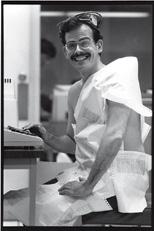“The Best Toga Party on Campus”
By Emily Gold Boutilier
 Griffiths, in 1983, proves that progress sometimes takes us backward: It’s much harder to make a toga out of 21st-century computer paper.
|
At the height of the dot-matrix era, Amherst magazine ran a photo of a man wearing a toga made out of a long, perforated sheet of computer paper, with the caption: “This is rumored to be Professor Griffiths of the Classics Department, who thinks word processing is the best toga party on campus.”
Presumably, Rick Griffiths was being funny on purpose, but over the years, the magazine has run several tech stories that are funny only in retrospect. Take, for example, a 1978 article about “the college’s academic computer, an IBM 1130, and the administrative computer, a Univac Series 70.” In addition to describing, in elaborate detail, the air conditioning system required to cool these two machines, the article reported that there are no computer science courses at Amherst because “students can get it on their own” and “it’s not particularly consistent with the idea of a liberal arts education.” (Tell that to today’s computer science department.)
In 1994, it was news when an Amherst president read his email. Reprinting an Amherst Student report, the magazine revealed that President Peter R. Pouncey “finally checked his electronic mail on October 19.” Pouncey’s reaction: “The notion that I am going to be nailed down here fielding the frivolities of all comers seems a little distasteful.” One student’s take: “Pouncey seems like more of a person-to-person talker.” A year later, a news item proudly proclaimed that “Amherst Athletics has entered the world of Cyberspace,” meaning that its homepage (with its mile-long URL) would post scores and highlights weekly.
In the prescient category is a 1966 feature by G. Ernest Anderson ’50, who, decades before Facebook and identity theft, worried about privacy in an age of electronic records. “Perhaps,” he wrote, “the confidentiality question is really one of insuring that an individual may have a ‘clean slate’ at various times in his life—that a machine records system will allow the vicissitudes of youth to pass gracefully into oblivion as manual records do today.”
Also lasting is the observation that Sarah Auerbach ’96 made in “Click Here for Employment.” The 1996 article—which described “the World Wide Web” as “a subset of Internet machines (sites) that serve up textual and graphical information (pages)”—reported that students are using the Internet to find jobs, and that alumni can, too.